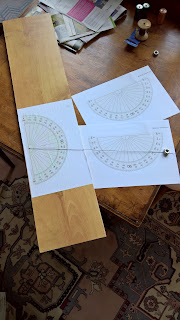The astrolabe mentioned at the end of reference 1 has now been constructed. Roughly as follows.
Ask Google for a picture of a protractor.
Import the picture into MS Powerpoint and blow it up as big as the (quite large) screen allows. Print it off.
Prepare plank from a length of some kind of faced fibre board; possibly once panelling for a piece of flat pack furniture. Kept on in case it came in useful some time.
Place paper projector on plank, mark and then drill hole at the centre.
Stick projector to plank using white glue intended for use in children's playgroups. Allow to dry.
Fit pendulum, using a nut at the loose end, a button at the plank end and some linen thread in between. A relative of the pack thread last mentioned at reference 3.
With a little practise it proves possible to make reliable observations of the altitude of things above the horizon. I hold the astrolabe like a rifle and sight (with the right eye) along its top edge, rather as one would use a gun sight. And I use the trigger finger, the first finger of the right hand to capture the thread at the point of observation, so as to capture its position for read out a few moments later. It helps to steady the pendulum just before making the observation.
First observation of the full moon. 14 degrees altitude at 1735.
Second observation. 47 degrees at 2130. Not as high as I would have guessed, but much more reasonable from an astronomical point of view.
Third observation. 49 degrees at 2210. Sadly, a lot easier to take the observation from outside than from the inside.
Reference 1: https://psmv4.blogspot.com/2020/02/dorking-two.html.
Reference 2: https://en.wikipedia.org/wiki/Astrolabe. I think my contraption qualifies.
Reference 3: https://psmv4.blogspot.com/2019/11/duffel-coat.html.
Group search key: mna.

No comments:
Post a Comment